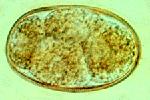Difference between revisions of "Ancylostomatoidea Structure and Function"
Jump to navigation
Jump to search
| (19 intermediate revisions by 2 users not shown) | |||
| Line 1: | Line 1: | ||
| − | |||
| − | |||
| − | |||
| − | |||
| − | |||
| − | |||
| − | |||
| − | |||
| − | |||
| − | |||
| − | |||
| − | |||
| − | |||
| − | |||
| − | |||
== General Appearance == | == General Appearance == | ||
[[Image:Ancylostoma.jpg|thumb|right|150px|''Ancylostoma'' - Courtesy of the Laboratory of Parasitology, University of Pennsylvania School of Veterinary Medicine]] | [[Image:Ancylostoma.jpg|thumb|right|150px|''Ancylostoma'' - Courtesy of the Laboratory of Parasitology, University of Pennsylvania School of Veterinary Medicine]] | ||
| − | + | *Like the Strongyloidea, except the head is bent dorsally | |
| − | + | *All have a large buccal cavity with teeth and/or cutting plates | |
| − | + | *Some also have teeth and/or cutting plates around the mouth[[Category:Ancylostomatoidea]] | |
| − | + | [[Category:To_Do_-_Parasites]] | |
| − | |||
| − | |||
| − | |||
| − | |||
| − | |||
| − | |||
| − | |||
| − | [[Category:Ancylostomatoidea | ||
| − | |||
| − | [[Category: | ||
Revision as of 21:54, 25 June 2010
General Appearance
- Like the Strongyloidea, except the head is bent dorsally
- All have a large buccal cavity with teeth and/or cutting plates
- Some also have teeth and/or cutting plates around the mouth
